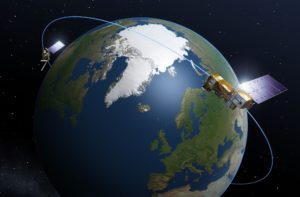Today’s “space race” is becoming defined by the quest for more affordable launch capabilities for the military, government and commercial environs; reusability is a potent means to reduce costs as well as to secure market leadership. Reusability places an even greater value on reliability—heritage firms that have specialized in aerospace technologies and systems since the days of Apollo are now playing a pivotal role in enabling the “new space” economy. Photo courtesy of Blue Origin.
Heritage Impact
Heritage technology originally carried Americans into space. Quite an achievement, of course, but even more remarkable when one considers that today’s sophisticated (and seemingly indispensable) design tools and optimization technologies were not yet available.
Saturn V, Apollo’s launch vehicle, would no doubt have been lighter and more powerful if it had been produced using the same extraordinary advancements in engineering tooling that benefit today’s space system developers. Saturn V’s actual size and performance capabilities were defined by the computational power of its era—resulting in extremely robust design as the mechanism to protect human life and hardware investments.
Today, the high reliability associated with these man-rated designs aligns perfectly with current goals for long lifecycle reusability. Developed for rigorous performance in the earliest days of the space program, these proven components are “by design” ready for today’s new space innovators. They are inherently more reliable and reusable because they are not necessarily operating at the limits of their capacities.
Perspectives on Reusability
By calling on a rich history of human space flight—breakthrough advances that defined the successes of Apollo, Saturn and even milestones such as breaking the sound barrier—new space innovators have access to flight-qualified technologies that can shape their competitive goals.
Tenured aerospace engineers (and their specific knowledge of various proven systems as well as recent innovations) are now onboarding into new space programs, fostering a somewhat unexpected path to affordability. How? By exploring what kinds of systems can be built using existing hardware, and engineering or re-engineering them to meet – and often exceed – customer specifications. Conversely, engineers from 21st-century graduating classes are appearing on the scene, eager to apply their skills and new-found knowledge. While the blend of both perspectives can be challenging from a management perspective, savvy organizations are reaping the rewards of this diversity by embracing the evolution taking place in their midst. The strongest performers in the “new space” sector are blending the nimble and agile with the reticent and experienced to create talent pools that are anchored in worldly wisdom while encouraging young minds to push the envelope and challenge the status quo.
Whether or not reusable technology is determined to be suitable for human space flight, man-rated systems have an impact on the affordability equation. The same reliability enables flexibility for new space competitors, allowing them some creativity in how to approach their individual reusability strategies.
This is an unexpected upside. Systems are poised for multi-use, combining the high reliability associated with man-rated technology with the conservatism of design and the vigor inherent to the early days of space system development. Onboard systems and components can be used with performance operating up to critical limits, or below critical limits, as a means of extending lifetime and therefore reusability.
Economic Advantage as a By-Product of Diversity
Clearly, building reusable launch vehicles without the need to invest vast sums on engineering new technologies is a key strategic advantage for front-runners in the new space race. And the truth is, it’s quite achievable.
Global brands familiar to the masses may do well to realize they can’t do it all well, all by themselves. Smaller companies which have honed their skills with laser focus in specific systems and sub-systems are uniquely qualified to fill the voids often found in multi-national global matrix organizations. Some of the smaller innovators are perfectly positioned to become value-add partners with the “big guys” – ultimately, for the mutual benefit of all.
Responsiveness is required, driving more firms to decide whether they can and want to thrive in new space projects. This includes all facets of operations, from design and manufacturing to sourcing and pricing components.
One company, Marotta Controls of Montville, New Jersey, is ideally positioned to service both new space and institutional programs; the firm is privately owned, with a deep catalog of flight-qualified hardware, and an agile decision-making process that reflects a lean and flexible management structure.
Redefining the Market
SpaceX and Blue Origin – two companies Marotta works with – have already successfully landed and recovered first stage engines. SpaceX is close to executing their first launch of a reused first stage, while Blue Origin’s New Shepard sub-orbital vehicle has relaunched five times with only minor refurbishment between launches.
First stage reuse likely offers the most return on investment, with second stage reuse considered worthwhile. While all reusable technology should create a program advantage through hardware savings, viewpoints differ on just how much of a cost reduction is possible in the future.
Progress toward price reduction continues in general, and reusable technology will amplify and accelerate the pace. For example, SpaceX’s Falcon 9 launch cost is currently ~$60M, while Ariane 5 is ~$120M with two satellites onboard. Ariane 6 promises to reduce per-kilogram prices by 40-50 percent, to be more competitive with Falcon 9. With a reusable option, Falcon 9’s costs will also drop; published estimates suggest a 30 percent reduction in its launch costs.
Just as important is the need to capitalize on the availability of heritage technology in new space programs. Flight-qualified designs that got us to the moon and back offer intrinsic reliability, the key factor in launching hardware into space more affordably. Meshing “heritage” and “new space” cultures is the new model for space design and development. For Marotta Controls, the mission has always been and will always be centered and focused around the successful missions of its clients.
Marotta Controls
Aligning heritage technology with the agility required for new space innovation is an ideal, yet surprisingly unique, strategy for established technology developers. Marotta Controls is one of only a handful of firms that bridge the gap between heritage technology and the new space economy, building on proven, applicable technologies and an agile and responsive culture to enable a new generation of innovators.
While the company’s expertise has steadily been built on institutional programs dating back to Apollo, Saturn V and the Lunar Module, Marotta’s technology is also part of space programs like Atlas, Delta, Taurus, New Shepard, Falcon 9 and SpaceShip Two.
Marotta’s patented valves were used on the Gemini spacecraft and Titan launch vehicle programs to control the fuel and pressurization systems during critical fueling and launch countdown sequences.
The company’s solenoid valves were used in Saturn V’s environmental control system, cooling electrical equipment required to guide, navigate, and command and control the Saturn launch vehicle from liftoff to Apollo/Saturn vehicle separation.
Marotta was also on board the Space Shuttle, providing technology as part of the program’s Solid Rocket Booster (SRB) system, helping the Orbiter escape Earth’s gravity using a system designed for recovery and reuse in future missions.
Marotta’s resumé ensures intelligent control systems and technologies that are inherently reusable, developed from early design protocols requiring specific parameters suitable for manned space flight.
About the Author
Bryan Reid has over 30 years of experience in the international Aerospace and Defence industry in both technical and commercial roles. He is instrumental in developing Marotta’s space strategy and securing significant technology content on major platforms. He’s been involved in a wide range of launch vehicle and satellite programs, including the Ariane 5 first stage Vulcain Engine, the GOCE (Gravity field and steady-state Ocean Circulation Explorer) satellite, and most recently, the Spacebus Neo and MetOp-SG platforms.
Bryan Reid is the Director of Business Development, Space Systems, for Marotta Controls, Inc.
Contact Bryan at: [email protected]
About Marotta Controls
Founded in 1943, Marotta Controls is a fully integrated solutions provider which designs, develops, qualifies and manufactures innovative systems and sub-systems for the aerospace and defense sectors. Our portfolio includes pressure, power, motion, fluid, and electronics controls for satellites, launch vehicles, aircraft systems, weapon systems, and shipboard applications. With over 200 patents, Marotta continues to build on its legacy, and is one of the fastest-growing family-owned technology companies based in the state of New Jersey.
Download Full Article Here[wpdm_package id=’9193′] |






